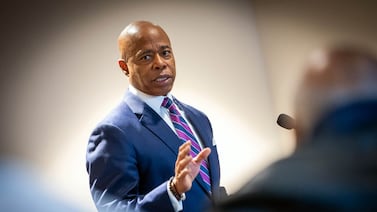For years, Colorado has relied on standardized test scores to provide a picture of which schools and students are doing well and which are doing poorly. Tests determine how schools are rated and which ones get outside intervention. The tests also play a major role in how teachers are evaluated.
But this spring, as students were forced home, schools didn’t administer tests, leaving a gap in our understanding of student achievement. With students having uneven access to instruction, many educators and advocates fear that academic gaps among students, especially along racial and economic lines, will have widened.
Further complicating the picture, schools are planning for an uncertain fall in which classroom learning might be interrupted by extended closures to control outbreaks and the ongoing trauma of living through a pandemic.
What should school accountability look like in this context?
Earlier this spring, the Colorado Association of School Executives asked for a two-year pause on rating schools using test scores.
“The challenges imposed on schools, school districts, and students as a result of the COVID-19 pandemic will directly impact testing for the foreseeable future, making test scores inconsistent and unreliable,” the group wrote.
The idea raised the hackles of advocacy groups that argue that without data, the most vulnerable students will slip through the cracks, and it didn’t get much traction with lawmakers, in part because the federal government requires the administration of certain assessments. The U.S. Department of Education issued waivers liberally this year but may not do so next year — though at least one state has already asked.
Instead, the legislature has called for the Colorado Department of Education to convene a group of educators and others to recommend what accountability should look like in the 2020-21 school year and beyond. That group is expected to start work in September.
Meanwhile, a coalition of advocacy groups has called for the Colorado Department of Education to use federal money to develop and administer a standard diagnostic test at the beginning of the school year to all Colorado students.
“While some suggest that no reasonable observer could expect schools and districts to make up for the lost instruction time in just a single school year, such arguments undermine an overarching goal of education — providing high-quality, impactful academic instruction,” the groups wrote in a letter.
“Families and communities deserve to know how the great experiment in remote learning impacted learning across the state. A uniform diagnostic assessment across Colorado, benchmarked to grade level expectations, empowers parents and community members with knowledge to make informed decisions.”
When school resumes in the fall, “we will not have had any information about student learning in a formal way for 18 months,” said Van Schoales, executive director of the advocacy group A Plus Colorado, which authored the letter. “That is a huge amount of time.”
Other groups that signed onto the request include Democrats for Education Reform, Colorado Succeeds, Ready Colorado, Colorado Latino Leadership, Advocacy, and Research Organization, African Leadership Group, and Stand for Children Colorado.
State education officials are weighing the request and talking to districts. Such a test wouldn’t be used as part of the state accountability system, but it would provide a way to compare districts and students.
Bret Miles, executive director of the Colorado Association of School Executives, said many district leaders agree that assessing students will be critical to tailoring instruction in the coming school year, but he argued such assessments are better done at the district and school level, rather than rolling out a new test. It would also take time to train teachers to administer the test. He suggested the results of a new assessment might not be valid, given all the constraints.
“Districts are preparing to welcome back to school students who have had their worlds turned upside down,” he said. “Teachers and staff will have to instill some sense of normalcy and stability to help promote learning first and foremost. That is a more urgent priority than developing a new assessment. When students are in that routine again, teachers will be able to gather good information.”
Opponents of a uniform diagnostic test, including many teachers, have launched a change.org petition calling on the department to instead use all its federal relief allotment — roughly $12 million — on direct support for academic and social and emotional needs.
Schoales said large districts might have good diagnostic tools already at their disposal, but many small districts don’t — and shouldn’t have to worry about coming up with one or paying for it on their own.
“The state has an obligation to make sure students are meeting state standards and expectations, so the state should make sure districts have diagnostics that can measure that,” Schoales said.
Districts took various approaches to remote learning this spring, and a uniform assessment would give some sense of what worked and what didn’t, Schoales said. That information will be valuable if schools have to toggle between remote and in-person instruction next year.
The disagreement about measuring student learning echoes many long-standing debates about the accountability system that are likely to play out before the education department’s stakeholder committee.
Critics of standardized tests say their results say much more about students’ socioeconomic status than about their academic ability or the work happening in their schools. Supporters of using test data to measure and rank schools say that it provides valuable information to drive improvement and empower parents.
Nicholas Martinez of the parent advocacy group Transform Education Now agrees that the existing accountability system doesn’t give a complete picture of what schools do, but he fears having no hard data.
“Everybody recognizes the need for change,” Martinez said. “The system we have is not perfect. Just a sole test does not honor the hard work of everybody involved, parents, students, educators. But it keeps me up at night if we throw it all out and have nothing. There is an opportunity to be creative in how we do this.”
When schools closed, parents became more involved than ever in their children’s education — and in some cases more concerned than ever about how their children were doing, said Martinez, whose organization also signed the letter calling for a statewide diagnostic.
“Families want to know: How can I measure my progress?” Martinez said. “My kid is going to be a sixth grader in the fall. I want him to be ready. How can I know he’s where he needs to be?”








